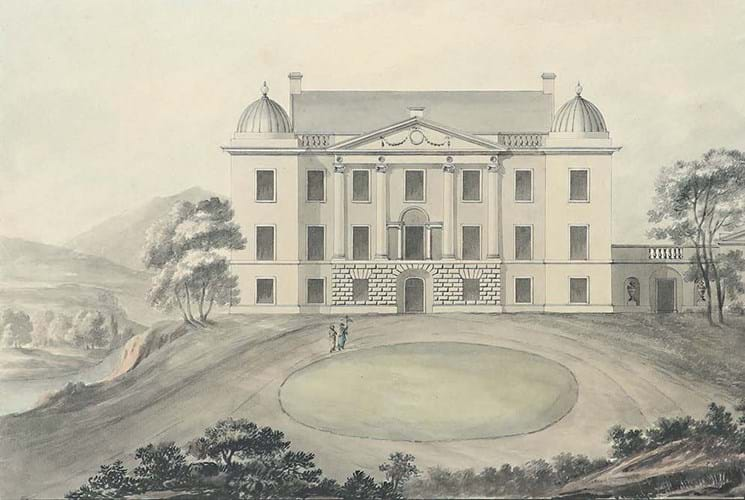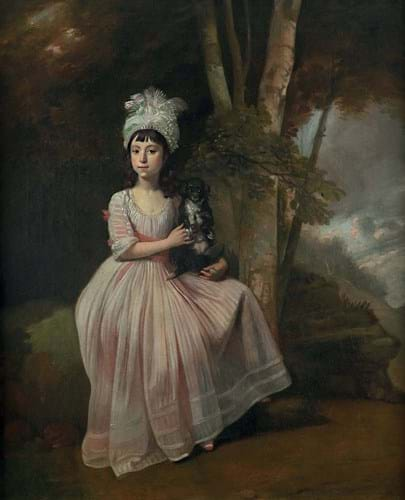
A bumper total of just over £750,000 was racked up at Salisbury saleroom Woolley & Wallis (25% buyer’s premium) in a 386-lot sale dedicated to Old Masters and British and continental paintings.
A third of the total from the March 4 auction was from a private collection in Oxfordshire that had come via descent from the Houstoun-Boswall family where the contents had been for over 50 years.
The group comprised almost entirely of 17th and 18th century Dutch, German and Italian paintings with the exception of a signed pen and watercolour drawing by the neoclassical architect Robert Adam (1728-92).
This 14 x 20in (35 x 51cm) work, which sold to the London trade for £2600 against a £1000-1500 guide, depicted design proposals for Blackadder House. It had been built some 20 years earlier as part of the medieval Blackadder estate positioned on the Scottish border near Allanton and owned at the time by the Houstoun-Boswall family.
Adam’s designs, dating to c.1784, were made for Alexander Boswall and proposed a number of alterations and additions to the front and side elevations but whether these were ever executed is difficult to ascertain as the house was demolished in 1925.
Adam’s architectural drawings and designs do appear on the secondary market from time to time but many have ended up in public collections. The Sir John Soane’s Museum in London contains a number of Adam’s designs, including for Blackadder House.
Picture topper
The 14-lot Houstoun-Boswall assemblage, which was just over half sold, was led by a pair of oil on copper paintings attributed to Jacopo Amigoni (1682-1752) which achieved £260,000, becoming the highest price for a picture lot at the Salisbury saleroom (see News, ATG No 2433).
The consignment also included a typical work by 16th century Flemish master Pieter Neefs the Elder (c.1578-1646) who specialised in architectural paintings of church interiors. Church interiors offered Neefs the opportunity to demonstrate his mastery of linear perspective, a skill that was much admired by connoisseurs of the day.
The signed 2ft 4in x 2ft 11in (72 x 88cm) oil on canvas, dated 1653, depicted the interior of Antwerp Cathedral – the artist’s most common subject – and was knocked down to the London trade on bottom estimate at £25,000.
Georgian Jewell
Elsewhere in the sale, a late 18th century English School painting estimated at £2000-3000 of a young woman in a pink dress, exotic headdress and holding a dog did rather better than expected.
The 2ft 6in x 2ft 1in (76 x 63cm) oil on canvas of Anne Jewell, which had been consigned by a direct descendant of the sitter, was knocked down to a trade buyer at £22,000.
The auction house said the execution of the dress in particular was “very well painted” but the price was a surprise nevertheless. An inferior portrait of the sitter’s mother, also Anne Jewell, seemingly by the same hand, was offered as the lot before and made a fraction of the price, selling on top estimate at £2500.
A c.1700 German School landscape based on what is thought to be a lost original painting by Claude Lorrain sold to the German trade for £11,000 against a £1000- 1500 estimate.
The 16 x 20in (40 x 51cm) oil on copper of a river landscape with a boat building had been exhibited at the Belfast Art and Industrial Exhibition in 1895 as by the Dutch Golden Age painter Aelbert Jacobsz Cuyp and came to Woolley & Wallis from the ‘property of the Noblewoman’.
The auction house said after the sale: “The original is thought by many to be lost, although some believe that a copy in an American museum is the original (the catalogue raisonné says not). That aside, the 18th century Italianate nature of the painting seems very popular at the moment.”
A 17th century portrait of the armour-clad Royalist Sir John Boys, who fought for Charles I from the beginning of the Civil War and was Governor of Donnington Castle, more than doubled hopes to sell for £6200.
The 2ft 6in x 2ft 1in (77 x 64cm) oil on canvas was attributed to the great English court painter William Dobson (1611-46) and had sold previously at a saleroom in Yorkshire last July for £3200.
A UK trade buyer paid £5800 for a striking unfinished oil study of Judith from Cristofano Allori’s (1577-1621) Judith with the Head of Holofernes in the Royal Collection. The undated 11½ x 9in (29 x 23cm) study was bought by the UK trade buyer, who paid over 23 times the top estimate.
Among the works on paper was a George Romney (1734-1802) study of Georgiana, Duchess of Devonshire (1757-1806) who is believed to have sat for the painter on at least seven occasions.
The 11 x 6½in (28 x 17cm) pen, brown and ink wash was in good condition and had been in the collection of the Duchess’ father, 1st Earl Spencer (1734-1783), and more recently with the London dealer James Faber. A private UK buyer secured the drawing for £4000 against a £3000-5000 estimate.
Duck by candlelight
The only candlelit scene known to have been painted by the Utrecht artist Jacob Duck (1600-67) was secured by a Dutch buyer for a triple-estimate £9500.
Painting in Utrecht during Duck’s lifetime was largely the domain of the Caravaggisti, but he took a different direction, modelling his style on the works of the Amsterdam artists Pieter Codde and Willem Duyster. He concentrated on contemporary genre scenes, particularly those of guardrooms and interiors with elegantly dressed figures.
Card players in candlelight, the 15 x 12in (38 x 30cm) oil on canvas offered in Salisbury, had provenance to the Paris-based financier Jules Porgès (1839-1921) and had last been offered at auction at his posthumous sale in Berlin in 1926.
The 15 x 12in (38 x 30cm) work was also authenticated by Dr Jochai Rosen, the author of Duck’s catalogue raisonné, and dated to c.1655-1660.
















